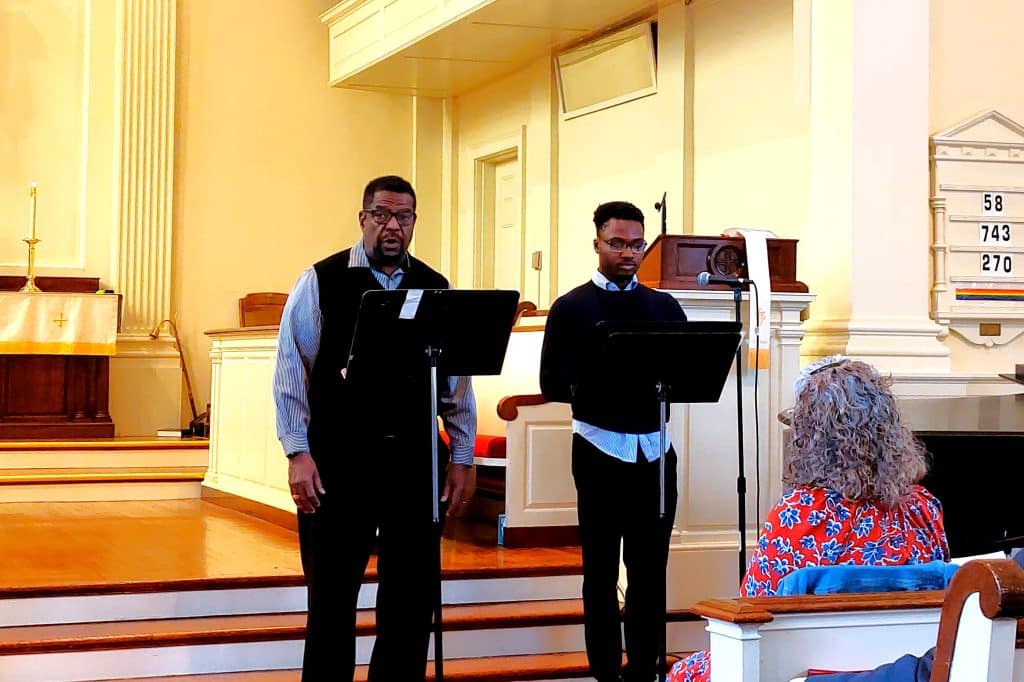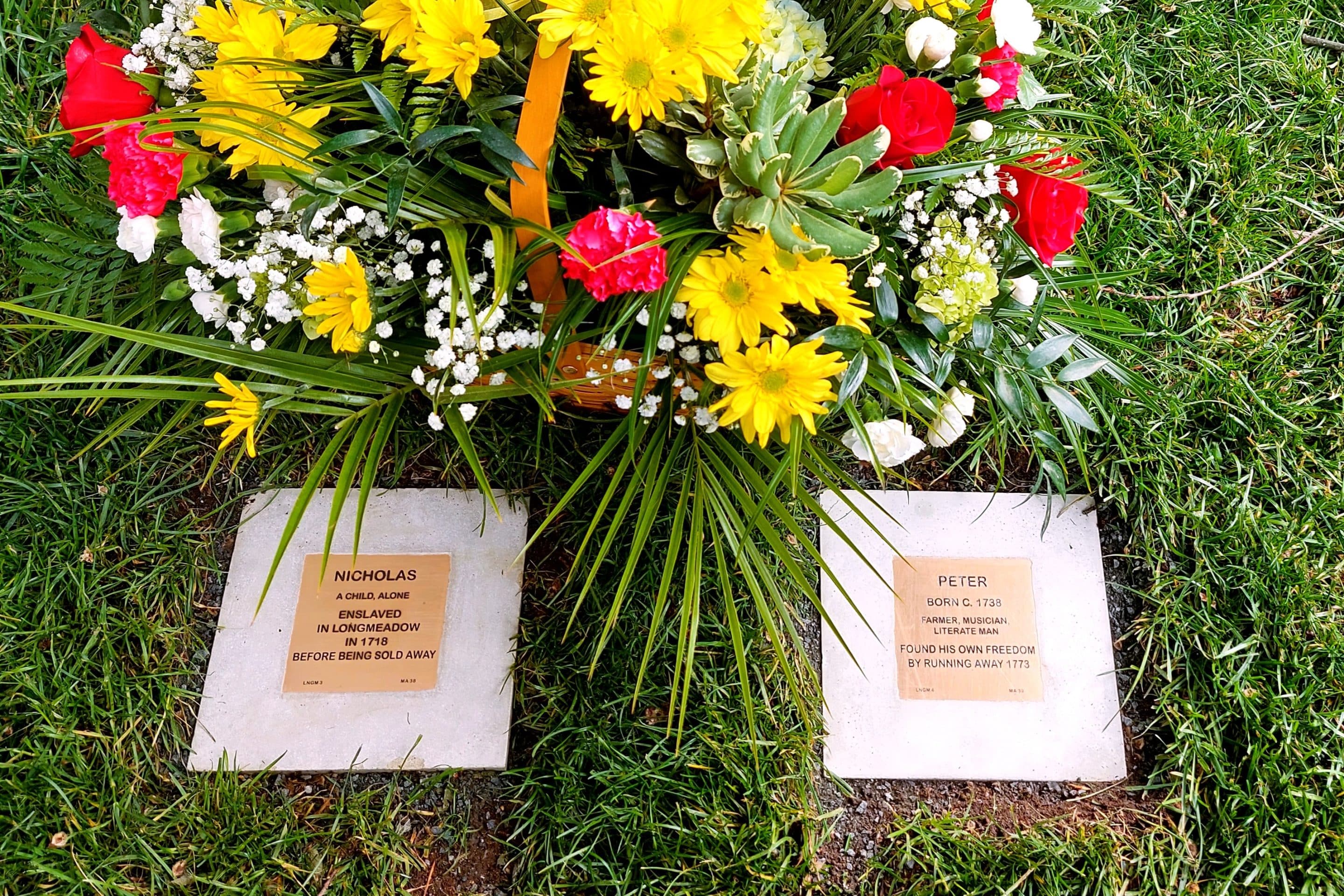Brass plaques set in the lawn outside First Church of Christ in Longmeadow to remember two enslaved people from the 1700s.
Reminder Publishing photos by Sarah Heinonen
LONGMEADOW — In 2024, the Longmeadow community remembered two enslaved people who lived and died in the town. Two stone markers, inscribed with the names of Phillis and Peter and information about their lives, were embedded in the ground in front of the First Church of Christ. On May 29, the lives of two more enslaved people were honored with their own stones.
The Witness Stones Project is a middle school curriculum created by Dennis Culliton that teaches students how to research and honor people enslaved in the United States. Culliton was inspired by Stolpersteine, brass plaques set into the pavement in front of the last address of people known to have been murdered in the Holocaust. Like many who died in the Holocaust, there are few stone grave markers to remember the resting places of enslaved people.
In Longmeadow, The Witness Stones Project is a collaboration between First Church of Christ of Longmeadow, the Historical Society and Longmeadow Public Schools. While last year’s Witness Stones were paid for with a Mass Humanities grant, this year’s project was funded by the Longmeadow Educational Endowment Fund.
Teachers at Williams Middle School led their seventh graders in researching the lives of the two enslaved people by using primary sources, such as census and church records, private letters and diary entries. Rev. Stephen Williams, Longmeadow’s first minister and the person for whom Williams Street is named, was Nicholas and Peter’s slaveholder. He was meticulous in keeping a diary, providing fertile research material for students three centuries later.
Nicholas was the first person known to be enslaved in Longmeadow, while Peter was the last. They, along with Phillis and Peter, are only four of the 16 individuals known to be enslaved by Williams and several other influential families in colonial Longmeadow during the 18th and 19th centuries.

Reminder Publishing photos by Sarah Heinonen
Various students read information about Peter and Nicholas and a poem expressing the emotions they may have felt. Nicholas was a child, thought to be about 8 years old and separated from any family. Williams began writing about Nicholas less than a year before selling him in 1718. In that time, Williams’ diary entries showed that Nicholas was an ill child that Williams thought of as lazy and disobedient. Williams wrote that he sold Nicholas “to a master that would keep him to business,” which Melissa Cybulski, Historical Society member and liaison for the Witness Stones Project, said was a reference to the child’s next enslaver, delivering even more harsh, physical abuse.
Williams wrote about Peter beginning in 1750. In that year, he attempted to escape captivity but was caught and put in prison before Williams again took ownership of him. He worked in Williams’ home, Longmeadow fields and Williams’ farm in Somers. Williams included Peter in his will as property, to be split between two of his sons. In 1773, Peter successfully escaped his bondage. An advertisement seeking Peter’s return shared that he was in his 30s, literate and played the fiddle. These details reflect more of the person that Peter was than any of Williams’ diary entries.
“This history is in danger of being forgotten,” First Church of Christ Reverend Doug Bixby said of the lives of enslaved people in New England. Bixby said the ceremony honoring Nicholas and Peter was designed to remember the enslaved with “humility, honor and respect.”
The school chorus sang “Lift Every Voice and Sing,” often referred to as the Black national anthem. Two church vocalists, Wycliffe Acquah and John Thomas, sang “Wade in the Water,” a traditional spiritual. Bixby noted that the song is thought to have had a coded meaning for those escaping captivity to travel through water to obscure their scent trail from dogs.
The students and those who had gathered for the event moved out to the church’s lawn, where flowers were placed by the witness stones of Peter and Nicholas, set in the ground next to those of Phillis and Peter. The church is raising money to install a plaque explaining the significance of the witness stones. After the ceremony, attendees were invited to view the students’ art projects, exploring the lives of Peter and Nicholas. The mediums ranged from posters and two-dimensional art to models and shadow boxes.
Former Connecticut state Rep. Patricia Wilson Pheanious, whose ancestors were among the first to be remembered by the Witness Stones Project, addressed the students. “You resurrected their lives,” she said, adding that what they had learned about Peter and Nicholas were “stories of resilience [and] bravery.” As a wider lesson for the students and those who attended the event, she said, “Inclusive knowledge of our history can only strengthen and heal us.”



